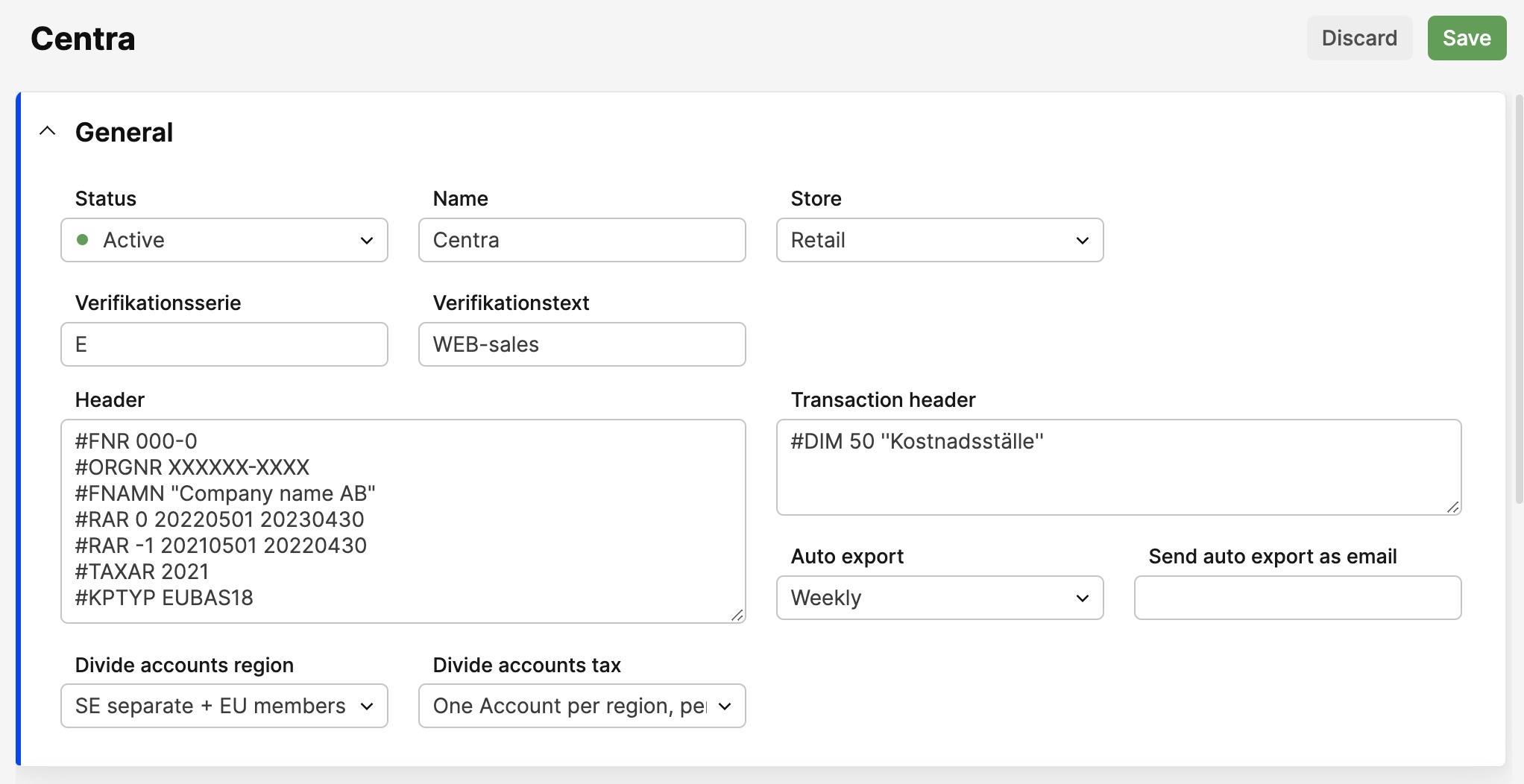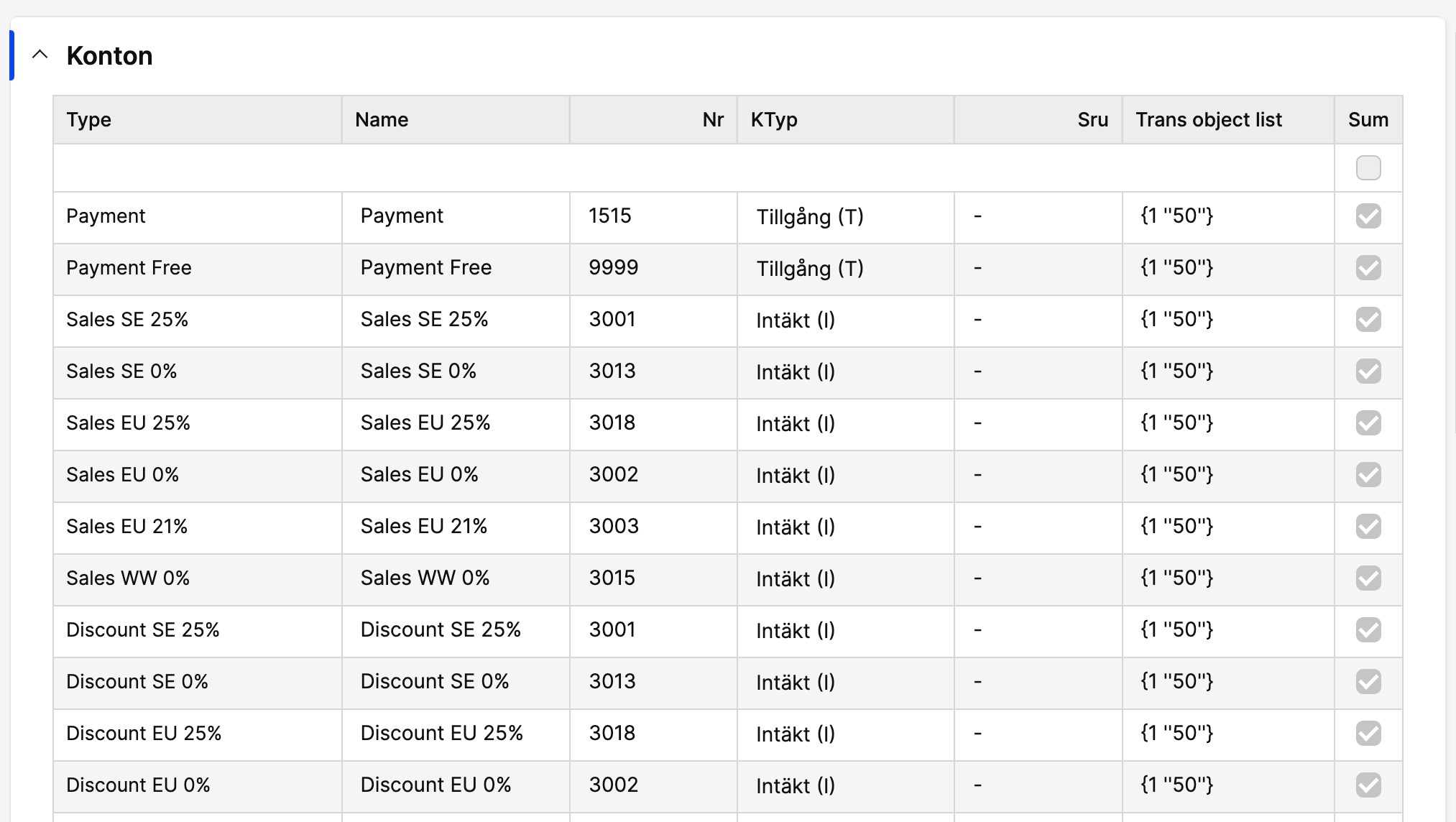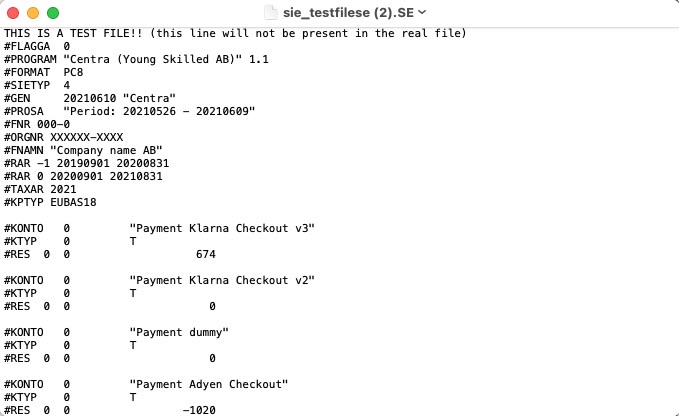SIE4 file
About this article
The SIE4 module exports data for bookkeeping softwares to import. SIE format is mostly used by Swedish bookkeeping companies, which is why this module is written in Swenglish.
How it works
First make sure the module is activated. To do so go to 'Modules' in the main menu to the left and click 'Sie4V2'. If you don’t have it yet, please reach out to Centra support to activate the module for you. Once activated you need to make sure your user privileges are set to have access to the added module under 'System' > 'Users'
“Account” in this module refers to a bookkeeping account, not a Centra account.
How to set up the SIE4 template
- Go to 'Modules' in the main menu to the leftand click 'Sie4V2'
- Click '+Create file' to generate a new template
-
Fill in the fields:

Status: Set the status to ‘Active’ (green)
Name: Name the file something suitable like “Dagsavslut”
Store: Select the correctStore you want the sales figures to be extracted from
Verifikationsserie: To structure your accounting, you can take advantage of different verification series for different type of accounting transactions. Add your Verification serie code/identifier here
Verificationstext: Add your verification name/description here
Header: Type in the header that needs to be in the file for your bookkeeping system to accept it
Transaction Header: Type in your chosen “Kostnadsställe”Header, Verifikationsserie, Verifikationstext and Transaction Header fields are directly injected into the file and what they contain will depend on the bookkeeping software this file will be imported into.
FNR – Financial reporting program’s internal code for the company which is exported
ORGNR – Organisation number
FNAMN – Företagsnamn – Company name
RAR -1 – Föregående Redovisingsår – Financial year from which the exported data is retrieved
RAR 0 – Nuvarande Redovisningsår – Financial year from which the exported data is retrieved
TAXAR – Taxeringsår – Taxation year which SRU codes relate to
KPTYP – Typ av Kontoplan – Chart of accounts type. “Specifies which charts of accounts type the exported chart of accounts is based on. The item is optional. If this item is missing, an input program should assume that the chart of accounts follows BAS 95.”Here you can read more about the SIE4 file codes and its meaning
Divide accounts region: Here you select how your sales/discount/shipping accounts should be divided ‘Sweden separate + EU members combined + WorldWide combined’ or ‘EU members separately + WorldWide combined’
Accounts Region Division
We allow you to divide your sales up in a few different ways, based on where the order was shipped and what tax applied to it.
- SE separate + EU members combined + WW combined
- Will require setup of one account for Sweden, one combined account for all countries in EU, and one combined account for the rest of the world
-
EU Members separately + WW combined
- Will require setup of one account per country that is in the EU and one for Worldwide
Divide accounts tax: Here you select if you want either to ‘Do not divide tax’, ‘One account per tax percentage’ or ‘One account per region, per applicable tax percentage’.
Tax Division
- Do not divide tax
- No extra divisions due to tax, also disables the tax dataset. If selected, all sales/discount/shipping prices reported will be including tax
- One account per tax percentage
- Divides sales/discount/shipping further to have one additional account per tax % available in that region
- makes sales/discount/shipping excluding tax and adds a tax dataset for taxes, ignores region for tax and just has one account per tax percent.
-
One Account per region, per applicable tax percentage
- Divides sales/discount/shipping further to have one additional account per tax % available in that region
- Adds the tax account, makes sales/shipping/discount ex tax and has one tax account per region, per tax percent.
Per 1st of July 2021 the new EU tax regulations (OSS) want you to select: Divide accounts region - ‘EU members separately + WorldWide combined’.
Auto Export: Here you can select if you want the report to be auto generated and how often Send Auto Export as Email: Here you can add the email address the file should be sent to when it’s auto generated
- Click 'Save'
- Now a list of all the accounts (Konton) are shown. Click 'Edit' to fill in which account each asset/type should be booked against

- Tick in 'Sum' if you want the transaction rows to be summarized in the file. We advise you to use this if you have a lot of transactions since some bookkeeping systems won’t accept very big files
- Click 'Save' when your done filling out the template
You can always export a test file by clicking 'Test export' to check how your file looks. It could look something like this:

A big part of bookkeeping is that everything needs to be balanced, so the values of this file should always equal 0. Payments balance with sales + shipping + tax - discount, and Stock balances with Item Cost and Rounding takes care of any discrepancy due to rounding errors. This module allows you to define templates which decide how the order and return data is divided on the different datasets that we export.
Datasets
Payment
- One account for each payment plugin for the selected store
- Contains a sum of all orders paid with this method
- Orders treated as debit, return as credit
Sales
- Summarizes original price of all items in the order
- One account per division settings
- Contains a sum of all orders shipped to this region (if we segregate on tax each item that matches this tax %)
- Orders treated as credit and returns as debit
Discount
- Summarizes the difference between original price and sale price, otherwise identical to how Sales work
Shipping
- Summarizes the shipping costs of the order, otherwise identical to how Sales work
Tax
- One account per tax division setting
- Contains the sum of all tax in this tax percent
- Orders treated as credit returns as debit
Stock
- Always just one account
- Summarizes the purchase price (cost) for each sold item
- Orders treated as credit, refunds as debit
Item Cost
- Always just one account
- Summarizes the purchase price (cost) for each sold item
- Orders treated as credit, refunds as debit
Rounding
- A SIE file has to sum up to 0, so this value will contain the difference between payments and sales/discount/shipping and tax
How to read the SIE4 file
Order transaction shows up based on the date the order was captured. Refund transaction shows up on the day the return was created, not when the money was refunded on the return and the refund process was finalized. If no return is created in Centra no return will show in SIE4 file either.

- First number after #TRANS is the account number the transaction row belongs to
- {1 “30”} is define by you in the account setup, in the column "Trans Object List" so it be something else
- The number after {} is the value
- The second last column is the date of the transaction as mentioned above
- Last column is the order number or if it has a - it is order number plus return ID
- SE separate + EU members combined + WW combined